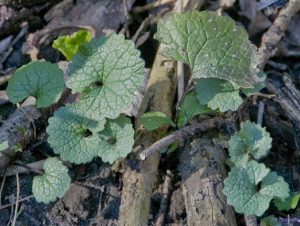Kill Garlic Mustard Now!

Right now is the best time to tackle problem garlic mustard because invasive plants are best attacked early days of spring, Wisconsin native plants are still dormant. Garlic mustard, however, has is green and growing. That makes this the best time to apply herbicide without damaging the spring wildflowers you love.
Garlic mustard has a type of biochemical antifreeze that allows it to remain green underneath the snow. As soon as the snow melts, this tough invasive begins soaking up sunlight and preparing to bloom in May and June.
Winning Strategy:
This time of year, the plant only shows a few leaves growing really close to the ground. These rosettes are particularly susceptible to foliar application of glyphosate as they are actively growing. As garlic mustard grows, the number of leaves increases and so the volume of herbicide needed to kill it increases, as well.
Because glyphosate is a short lived herbicide that breaks down in sunlight in just a couple weeks, it will be gone before spring ephemerals emerge. That makes right now the best time to head out and get ahead of your garlic mustard problem.
Read and follow label directions for foliar spray. Several companies manufacture glyphosate. Each markets the herbicide under its own name. Likewise, companies formulate glyphosate in differ concentrations. Some formulations are ready to spray right out of the bottle, while other products are concentrated to mix with water according to how you intend to use it. The trade name most people recognize it RoundUp. Read and follow directions on your specific product and application. You can buy glyphosate sold by other manufactures, usually for far less than the brand name.
Before You Start:
One note of caution, always mix glyphosate with softened water. Hard water will not cause glyphosate to harm your plants. The issue is that the calcium in hard water attracts and binds tightly to glyphosate. Hard water will cause you lose as much as 25% percent of the effectiveness of your application. When dealing with large infestations of garlic mustard, that 25% loss is likely to spell the difference between success and failure.
Garlic mustard needs time to soak absorb Glyphosate. That means you do not want to spray it as rain clouds are rolling in. The manufacturer usually recommends an hour of drying time following application. I try to give it half a day, if I possibly can. That ensures not only that leaves are dry. Also, most chemical is absorbed and being carried into the plant tissues.
Glyphosate interfere with enzyme 5-enolpyruvylshikimate-3-phosphate (EPSP) synthase, a chemical that is vital in protein synthesis and plant growth. Plants have this enzyme but animals do not, so it is not toxic humans. Some studies have shown a possible long-term cancer risk and several law suites made their way through the courts. Those people affected are folks who use the chemical heavily over many years, such as farmworkers and landscapers.
Handling Steps:
How you handle any herbicide is at least as important as how much you spray and how often. The way I keep myself safe is to treat even safe chemicals like glyphosate as though they were as dangerous and much more toxic chemicals like atrazine.
- Use proper personal protective equipment (PPE). For glyphosate that means eye protection, long pants, long sleeved shirt, rubber gloves and boots.
- Wash cloths separately at the end of each day.
- Mix only the amount of glyphosate you intend to use that day. Water begins to break down the chemical, so this is an effectiveness practice, as well as a means of risk reduction.
- Do your mixing in a contained area. I like to set the tank where I am mixing the herbicide in a pan with clay cat litter. That way, any spillage is trapped and can be easily disposed. If I am spraying a relatively small area, I will mix my glyphosate right in the sprayer.
- Read and follow label directions for foliar spray. Use specific instructions for garlic mustard if present. Otherwise look for the mixing instructions that best fit your situation.
- Add a colorant if you can to make it easy to see where you have sprayed.
- Do not spray when the wind is high or has shifting directions.
- Begin spraying at the downwind edge of the application site and work upwind. Avoid getting herbicide on you.
- Apply only as much glyphosate as it takes to over the leaves. Spraying past the point where chemical is running off the leaves is wasteful and adds unnecessary risk of damaging early sprouting native plants.
- Use up the chemical you mixed. You want to end up with an empty sprayer.
- Triple rinse your sprayer with water at the end of the day. You only needs to put in 20-25% of the sprayer with rinse water. Slosh it around and dispose of the water into a plastic rinseate container with a screw-0n cap. Use that rinse water as your water supply the next time you mix glyphosate. That way there is no waste or contaminated water to dispose of.
- Rinse off gloves and boots. Launder sites and pants separate from other laundry.
Repeat this regimen in late fall, after your native plants have gone dormant and only garlic mustard remains. Early spring and late fall garlic mustard treatment will give you the best control of garlic mustard with the least effort and expense.
